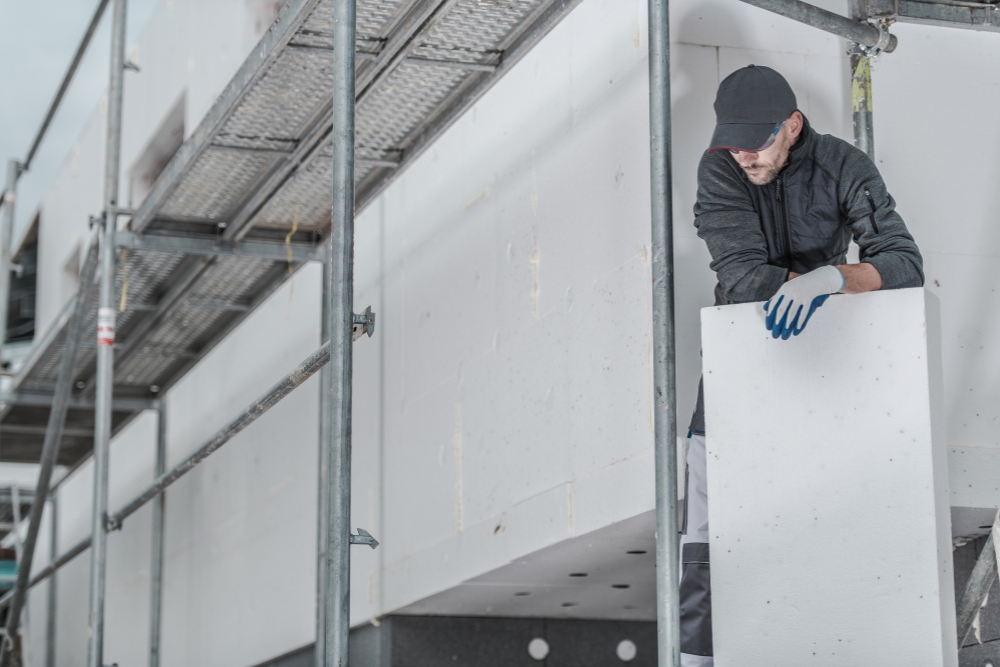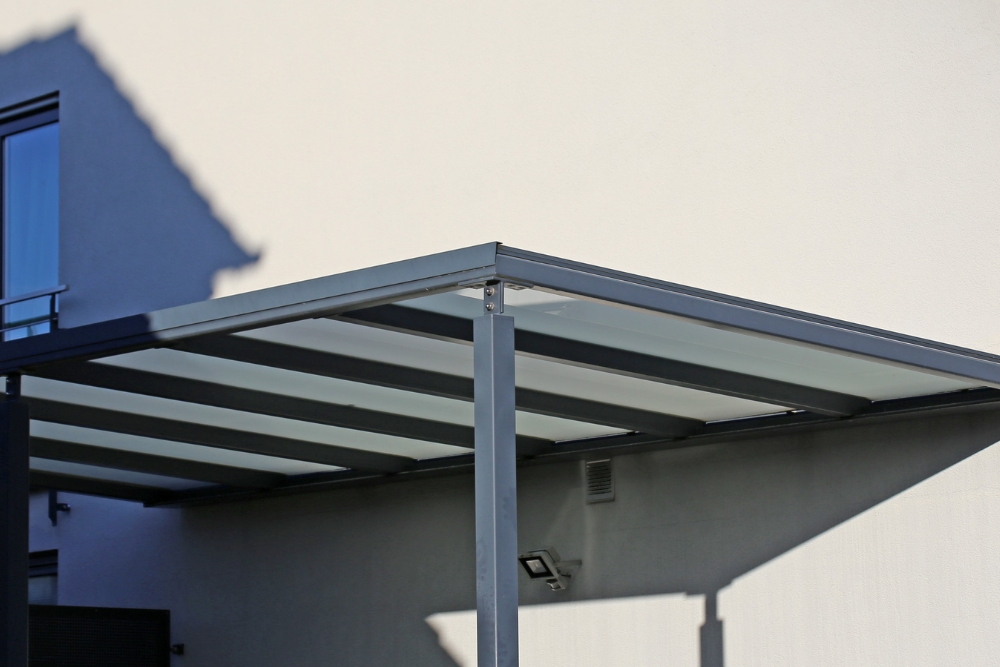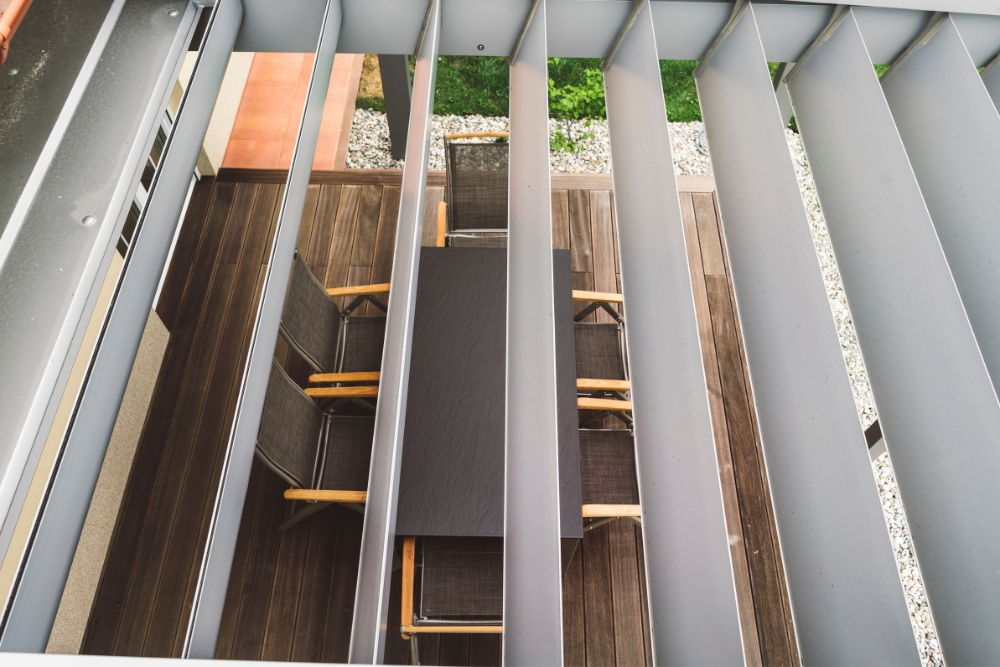Scouting for the perfect pergola to spruce up your backyard can really change the game, but it’s a fair shake that you might get bogged down picking between freestanding and attached aluminium beauts.
We know what it’s like getting your head around the strengths of each – and have you heard how ace aluminium is? Not only is it as light as a feather, but it’s tough as nails too.
Reckon we should sort out any muddle together? Our nifty guide on the upsides and downsides will set things straight, so you can smartly pick a winner that’ll make your outdoor space look bonza.
Ready to suss out which type of pergola will take your garden spot from good to great? Let’s crack into it!
Key Takeaways
- Freestanding aluminium pergolas offer flexibility and versatile placement within the outdoor space, allowing for creative design options without being limited by attachment to a building.
- Attached aluminium pergolas provide strong support and stability due to their connection to the building, offering additional structural strength and extended shade coverage over larger areas compared to freestanding pergolas.
- Both freestanding and attached aluminium pergolas are durable and corrosion-resistant options that cater to different outdoor living requirements, ultimately providing homeowners with distinct benefits based on their individual preferences, specific design needs, and desired use of the outdoor space.

The Difference Between Attached and Freestanding Pergolas
When it comes to choosing between attached and freestanding pergolas, the main differences lie in their structural stability and design options. Attached pergolas are connected to a structure for added strength, while freestanding pergolas offer more placement flexibility and open design possibilities.
Structural stability
Ensuring our pergolas stand strong against weather and time is crucial for us. Attached aluminium pergolas gain extra strength from the buildings they’re connected to, leading to enhanced durability and a longer lifespan.
This type of pergola becomes an extension of our home, benefiting from the existing structural support that’s already in place.
Freestanding aluminium pergolas impress with their versatility, allowing us to place them wherever we envision within our outdoor space. However, their stability depends solely on their construction and anchoring system since they don’t lean on any other structure for support.
They call for careful planning and quality materials to uphold against elements like wind or heavy rain but offer endless possibilities in design and placement around our properties.
Design options
When considering design options for aluminium pergolas, homeowners have the freedom to choose between freestanding and attached designs. Freestanding pergolas offer versatile placement within the outdoor space, creating a separate area for relaxation or entertainment without the need for attachment to a building.
On the other hand, attached pergolas provide structural stability by sharing support with the building they are connected to. Homeowners can explore various styles and sizes, as well as customisation options such as adding curtains or screens for additional privacy and weather protection.
The design possibilities for aluminium pergolas are extensive, allowing homeowners to tailor their outdoor living spaces according to their specific preferences and needs. Whether opting for a standalone structure or one that seamlessly integrates with the existing architecture, both freestanding and attached aluminium pergolas offer unique design advantages that cater to different outdoor living requirements.
Pros and Cons of Attached Pergolas
Attached pergolas provide strong support and stability, making them ideal for homes with limited outdoor space. However, their placement options are limited to areas adjacent to the house, and they require secure attachment for safety and durability.
Strength and support
Attached aluminium pergolas are known for their structural stability and robust support due to their connection to the building. The attachment provides added strength, making them a durable choice that can withstand various weather conditions.
This secure connection ensures that the pergola remains steady and reliable, offering a sense of security for both you and your outdoor living space.
On the other hand, freestanding aluminium pergolas may require additional support depending on their size and design. Although they offer flexibility in placement, it’s important to consider the potential need for reinforcing supports to ensure stability over time.
Limited placement options
When considering a pergola attached to your home, it’s essential to keep in mind the limited placement options. Unlike freestanding pergolas, attached ones are restricted to where the building allows for attachment.
This limitation may influence the layout of your outdoor space and impact the overall functionality and design possibilities. Homeowners should carefully assess their outdoor area and weigh whether the restriction of placement with an attached pergola aligns with their intended use and desired aesthetic.
For homeowners seeking a versatile option that isn’t bound by building constraints, freestanding aluminium pergolas offer more flexibility in placement, allowing them to be positioned anywhere within the outdoor space.
Secure attachment
Attached aluminium pergolas provide a secure attachment to the building, offering strength and stability. This secure connection ensures that the pergola is firmly supported and less susceptible to sway or movement during harsh weather conditions.
The attachment of an aluminium pergola to the home provides additional structural support, making it a durable and long-lasting outdoor living structure. Additionally, attached aluminium pergolas can offer more coverage and shade compared to freestanding ones, providing a sheltered outdoor space for various activities.
While attached aluminium pergolas offer secure attachment and exceptional stability, they are limited in their placement options as they depend on being adjacent to a building. However, this limitation is often outweighed by the peace of mind that comes with having a securely attached outdoor living space that seamlessly integrates with your home’s architecture.
Pros and Cons of Freestanding Pergolas
When considering a freestanding pergola, it’s essential to weigh the advantages and disadvantages. These structures offer versatility in placement and design but may require additional support and have a more open design compared to attached pergolas.

Versatility
Freestanding aluminium pergolas offer great versatility in outdoor design. They can be placed anywhere in the outdoor space, allowing for more creative and flexible placement options.
This allows homeowners to create a separate and unique outdoor living area away from the main building. Additionally, freestanding pergolas provide the opportunity to customise the layout and design according to specific aesthetic preferences or functional needs.
When considering an attached aluminium pergola, it’s important to note that they are limited by the location of the building they are attached to, which may restrict versatility in terms of placement and design options.
However, their secure attachment provides stability and support while also extending shade coverage over larger areas when compared to freestanding pergolas.
Potential for additional support
Attached aluminium pergolas provide excellent structural stability, but there might be instances where additional support is needed. This can be achieved by installing additional posts or columns as reinforcement to ensure the integrity of the structure.
These reinforcements can help distribute the weight and enhance stability, especially in areas with heavy wind loads or inclement weather conditions.
When considering the potential for additional support, it’s important to assess the specific outdoor location and environmental factors that may impact the pergola’s performance. Additionally, consulting with a professional installer can provide valuable insights into ensuring that your attached aluminium pergola is secure and stable for the long-term enjoyment of your outdoor living space.
More open design
Freestanding aluminium pergolas offer a more open design, allowing for an airy and spacious feel in the outdoor space. With no need to attach to a building, freestanding pergolas can be placed anywhere in the garden or yard, creating a separate and inviting outdoor living area.
This additional flexibility in placement allows for unique design possibilities, such as creating an alfresco dining space away from the house or defining a cosy relaxation spot under the shade of trees.
The openness of freestanding aluminium pergolas also provides an opportunity to bring nature into the design, offering unobstructed views of the surrounding landscape. Whether it’s overlooking a lush garden or enjoying a scenic backyard vista, homeowners can take advantage of this feature to create a serene and tranquil retreat right outside their door.
Comparing Materials: Aluminum vs. Wood Pergolas
Aluminium pergolas are lightweight and strong, requiring minimal maintenance compared to traditional wood pergolas. To find out more about the benefits of each material, keep reading!
Lightweight and strong aluminium
Aluminum is a popular choice for both freestanding and attached pergolas. Its lightweight yet durable nature makes it an ideal material for outdoor structures. This means that whether you opt for a standalone or wall-mounted pergola, you can be assured of its strength and stability over the long term.
With aluminium, you get the benefit of a low-maintenance material that resists corrosion, making it suitable for various weather conditions.
Aluminum’s strength and versatility make it an excellent option for creating sturdy, long-lasting outdoor living spaces. Whether you choose to go with a freestanding design to add character to your garden or opt for an attached structure extending from your home, aluminium provides durability without compromising on style.
Traditional and natural wood
Traditional and natural wood pergolas offer a timeless and classic look to outdoor spaces. They bring warmth and charm to any garden or backyard, creating a rustic and inviting atmosphere for outdoor entertaining and relaxation.
Wood pergolas can be customised to suit individual style preferences, offering a range of design options from sleek modern lines to more traditional ornate structures. While they require regular maintenance and are susceptible to weathering over time, the natural beauty of wood adds character to any outdoor living space.
Wooden pergolas also provide a sense of connection with nature, blending seamlessly into the surrounding environment. The organic feel of wood complements gardens and greenery, making it an attractive choice for homeowners seeking an aesthetically pleasing addition to their outdoor areas.

Choosing the Right Pergola for Your Home
Consider the placement and desired use, think about your budget and maintenance needs, and consider your personal style preference. To find out more about choosing the right pergola for your home, keep reading!
Consider placement and desired use
When choosing between a freestanding and attached aluminium pergola, it’s essential to consider the placement and desired use in your outdoor space. Freestanding pergolas provide versatility in placement, allowing you to create a separate outdoor living area away from the house.
This can be ideal for defining spaces within your backyard or garden while offering shade and an inviting ambience for relaxation and entertaining. On the other hand, attached aluminium pergolas are perfect for extending the living space of your home seamlessly into the outdoors.
By considering where you want to enjoy outdoor activities and how you envision using your pergola, you can make an informed decision based on your specific lifestyle and design preferences.
Budget and maintenance
When considering the budget for your pergola, it’s important to factor in not only the initial cost but also ongoing maintenance expenses. Freestanding aluminium pergolas may have lower installation costs due to not needing attachment to a building, however, they might require more frequent maintenance such as cleaning and resealing.
On the other hand, attached aluminium pergolas may involve higher initial costs but can be more cost-effective in the long run due to their sturdy attachment and lower maintenance needs.
Understanding these budget implications will help you make an informed decision that aligns with your financial plans and outdoor living goals.
Maintenance plays a significant role in preserving the longevity of your aluminium pergola. Both freestanding and attached options require regular upkeep to ensure their durability and aesthetic appeal remain intact.
With proper care such as periodic cleaning and inspection of joints or attachments, an aluminium pergola can maintain its structural integrity for years without succumbing to rust or corrosion.
Personal style preference
Considering personal style preference, it’s important to think about the overall aesthetic you want for your outdoor space. Freestanding aluminium pergolas offer more design flexibility and can create a separate outdoor living area with a unique style that complements your home.
On the other hand, attached aluminium pergolas blend seamlessly with the existing structure, creating a cohesive look while providing additional shade and coverage. Whether you prefer a standalone statement piece or a seamless extension of your home’s architecture, both freestanding and attached aluminium pergolas offer versatile options to match your personal style.
When it comes to personal taste, some homeowners may lean towards the modern and sleek appearance of freestanding aluminium pergolas, while others may prefer the traditional and integrated look of attached ones.
Enhance Your Space’s Appeal with Aluminium Pergolas
After weighing the pros and cons of freestanding and attached aluminium pergolas, it’s clear that each option offers unique benefits. Freestanding pergolas provide versatility in design and placement, offering a separate outdoor living space.
On the other hand, attached pergolas offer structural stability and can expand seamlessly from an existing building. Choosing between the two ultimately depends on individual preferences, specific outdoor design requirements, and desired use.
Both options provide durable and corrosion-resistant solutions for creating inviting alfresco areas or enhancing backyard designs.
Design your outdoor paradise with Aluminum Pergolas – but should you go freestanding or attached? Discover the perfect pergola for your space! Our range offers both freestanding and attached Aluminum Pergolas, catering to diverse tastes and preferences. Whether you crave a standalone retreat or an extension of your living space, we’ve got you covered. Elevate your outdoor experience and make a statement with our versatile Aluminum Pergolas. Dive into the world of possibilities – explore our freestanding and attached options now and transform your outdoor living! Contact Us Today!




